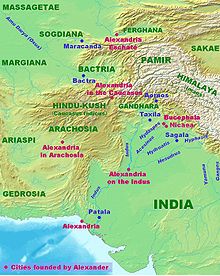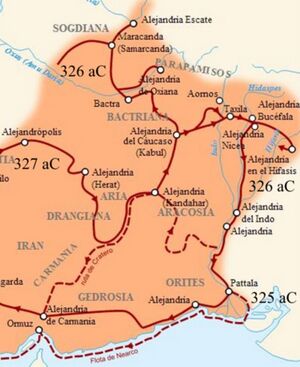Nikaia
| Author:Laxman Burdak, IFS (R) |


Nikaia (निकाइया) or Nikaea was the place where Alexander defeated Porus in 326 BC in the Battle of the Hydaspes.[1]. It has been identified with Karri (कर्री) in the Punjab region of the Indian subcontinent (modern-day Punjab, Pakistan).
Variants of name
- Astakia
- Nikaian निकाइयां (AS, p.500)
- Nikaia निकाइया (AS, p.500)
- Naka
- Na-k’eeh (by Fahian)
- Naki
- Nakki
- Nikaea
- Nicaea (Arrian: Anab.4.22, Book/5b)
- Bhadrashva - the cities of Nikaia and Boukephala were renamed as Adirajya and Bhadrashva.
Jat clan
Nakai (नकई) is a Muslim Jat clan found in Pakistan.
History
Arrian[3] writes....After defeating Porus, Alexander founded two cities, one where the battle took place, and the other on the spot whence he started to cross the river Hydaspes; the former he named Nicaea, after his victory over the Indians, and the latter Bucephala in memory of his horse Bucephalas, which died there.
Nicaea is supposed to be Mong and Bucephala may be Jelalpur. [4]
निकाइयां
विजयेन्द्र कुमार माथुर[5] ने लेख किया है ...निकाइयां (AS, p.500) एक प्रसिद्ध ऐतिहासिक स्थान का नाम है. जिसकी स्थिति झेलम नदी के किनारे कर्री नामक स्थान पर बताई गई है। 'अलक्षेंद्र' (सिकन्दर महान) के इतिहास लेखकों के अनुसार 'पोरस' (राजा पुरु) और यवन सम्राट के बीच होने वाले प्रसिद्ध 'झेलम के युद्ध' की घटना स्थली का नाम निकाइयां है। (दे.कर्री)
कर्री
विजयेन्द्र कुमार माथुर[6] ने लेख किया है ...कर्री (AS, p.146) पाकिस्तान के झेलम से प्राय: दस मील उत्तर पूर्वं वही रणस्थल है जहाँ अलक्ष्येन्द्र (सिकंदर) और पुरु या पोरस की सेनाओं के बीच 326 ई. पू. में इतिहास प्रसिद्ध युद्ध हुआ था। ग्रीक लेखकों ने युद्ध को झेलम का युद्ध कहा है और घटना-स्थली का नाम निकाइया लिखा है। यह मैदान लगभग पांच मील चौड़ा था। पुरु के पास तीस सहस्त्र पैदल सेना के अतिरिक्त दो सौ हाथी भी थे जिनको उसने हरावल में खड़ा किया था। सेना के पार्श्वो की रक्षा के लिए तीन सौ रथ थे। प्रत्येक रथ में चार घोड़े और छ: रथारोही थे। इनके पीछे चार सहस्त्र अश्वारोही सैनिक थे। पैदल सेना चौड़ी तलवारों, ढालों, भालों और धनुष बाणों से सुसज्जित थी। अलक्षेंद्र ने पुरु की सेना के सम्मुखीन भाग को अजेय समझ कर उसके वामपार्श्व पर आक्रमण किया। इसमें उसने अपनी अश्वारोही सेना का प्रयोग किया था। सायंकाल तक युद्ध समाप्त हो गया। [p.147]: अपनी सेना के पैर उखड़ जाने पर भी पुरु अंत तक अविजित तथा अडिग बना रहा और उसके वीरता और दर्पपूर्ण व्यवहार ने कुटिल अलक्षेंद्र को भी मोह लिया और उसने भारतीय वीर को उसका देश लौटा कर अपना मित्र बना लिया।
Visit by Fahian
James Legge[7] writes - After crossing the river, (the travellers) immediately came to the kingdom of Woo-chang,1 which is indeed (a part) of North India. The people all use the language of Central India, “Central India” being what we should call the “Middle Kingdom.” The food and clothes of the common people are the same as in that Central Kingdom. The Law of Buddha is very (flourishing in Woo-chang). They call the places where the monks stay (for a time) or reside permanently Sangharamas; and of these there are in all 500, the monks being all students of the hinayana. When stranger bhikshus2 arrive at one of them, their wants are supplied for three days, after which they are told to find a resting-place for themselves.
There is a tradition that when Buddha came to North India, he came at once to this country, and that here he left a print of his foot, which is long or short according to the ideas of the beholder (on the subject). It exists, and the same thing is true about it, at the present day. Here also are still to be seen the rock on which he dried his clothes, and the place where he converted the wicked dragon.3 The rock is fourteen cubits high, and more than twenty broad, with one side of it smooth.
Hwuy-king, Hwuy-tah, and Tao-ching went on ahead towards (the place of) Buddha’s shadow in the country of Nagara;4 but Fa-hien and the others remained in Woo-chang, and kept the summer retreat.5 That over, they descended south, and arrived in the country of Soo-ho-to.6
1 Udyana, meaning “the Park;” just north of the Punjab, the country along the Subhavastu, now called the Swat; noted for its forests, flowers, and fruits (E. H., p. 153).
2 Bhikshu is the name for a monk as “living by alms,” a mendicant. All bhikshus call themselves Sramans. Sometimes the two names are used together by our author.
3 Naga is the Sanskrit name for the Chinese lung or dragon; often meaning a snake, especially the boa. “Chinese Buddhists,” says Eitel, p. 79, “when speaking of nagas as boa spirits, always represent them as enemies of mankind, but when viewing them as deities of rivers, lakes, or oceans, they describe them as piously inclined.” The dragon, however, is in China the symbol of the Sovereign and Sage, a use of it unknown in Buddhism, according to which all nagas need to be converted in order to obtain a higher phase of being. The use of the character too {.}, as here, in the sense of “to convert,” is entirely Buddhistic. The six paramitas are the six virtues which carry men across {.} the great sea of life and death, as the sphere of transmigration to nirvana. With regard to the particular conversion here, Eitel (p. 11) says the Naga’s name was Apatala, the guardian deity of the Subhavastu river, and that he was converted by Sakyamuni shortly before the death of the latter.
4 In Chinese Na-k’eeh, an ancient kingdom and city on the southern bank of the Cabul river, about thirty miles west of Jellalabad.
5 We would seem now to be in 403.
6 Soo-ho-to has not been clearly identified. Beal says that later Buddhist writers include it in Udyana. It must have been between the Indus and the Swat. I suppose it was what we now call Swastene.
In Jat History
ठाकुर देशराज लिखते हैं कि जिस स्थान पद युद्ध हुआ था, सिकन्दर ने अपनी विजय के उपलक्ष में ‘निकय’ नाम का एक नगर बसाया था। जो कि ‘नकाई’ नाम से मशहूर हुआ। सिक्खों की बारह मिसलों में से एक मिसल का नाम नकई मिसल है जो कि वहां के नकई जाटों
जाट इतिहास:ठाकुर देशराज,पृष्ठान्त-200
के गांव के नाम से मशहूर हुई। निकय गांव के लोग अवश्य ही उस जाति के होंगे, जिसमें स्वयं पौरुष था। क्योंकि 200 गांवों के जिस प्रदेश को सिकन्दर ने सन्धि होने के बाद पौरुष को सौंपा था, यह गांव भी उन्हीं में शामिल है।
Nakai Misal
The chief of this Misal was Hira Singh Sidhu, a Jat of the Sandhu clan. The area lying between Lahore and Gogaira (now both in Pakistan) was called Naka country and during the middle of the eighteenth century A.D., Hira Singh took possession of it; thus the Misal became known as Nakai Misal.
References
- ↑ Alexander Cunningham: The Ancient Geography of India/Taki,p. 155
- ↑ Buddha Prakash: Evolution of Heroic Tradition in Ancient Panjab, X. The Struggle with the Yavanas, Sakas and Kushanas, p.101
- ↑ The Anabasis of Alexander/5b, Ch.19
- ↑ See Strabo, xv. 1.
- ↑ Aitihasik Sthanavali by Vijayendra Kumar Mathur, p.500
- ↑ Aitihasik Sthanavali by Vijayendra Kumar Mathur, p.146
- ↑ A Record of Buddhistic Kingdoms/Chapter 8
Back to Jat Places in Afghanistan

